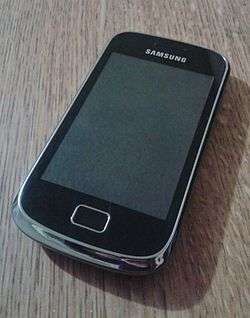Samsung Galaxy Mini 2
Samsung Galaxy Mini 2 is a smartphone manufactured by Samsung that runs the open source Android 2.3 "Gingerbread" operating system. It was announced and released by Samsung on February 2012. It is available in three colors: black, yellow and white.
 Samsung Galaxy Mini 2 | |
| Brand | Samsung |
|---|---|
| Manufacturer | Samsung Electronics |
| Series | Galaxy |
| Compatible networks | GSM 850/900/1800/1900, HSDPA 900/2100 |
| First released | February 1, 2012 |
| Availability by region | March 1, 2012 |
| Predecessor | Samsung Galaxy Mini |
| Successor | Samsung Galaxy Fame Samsung Galaxy Fame Lite |
| Type | Smartphone |
| Form factor | Slate |
| Dimensions | 109.4 mm (4.31 in) H 58.6 mm (2.31 in) W 11.6 mm (0.46 in) D |
| Mass | 105.3 g (3.71 oz) |
| Operating system | Original: Android 2.3.4 "Gingerbread" Last: Android 2.3.6 Gingerbread Unofficial: CyanogenMod 10.1 (based on Android 4.2 "Jelly Bean") |
| CPU | Snapdragon S1 / MSM7227A ARMv7: ARM Cortex-A5 800 Mhz |
| GPU | Adreno 200 |
| Memory | 512 MB RAM (398 MB available for user) |
| Storage | 4 GB (0.9 GB is available) |
| Removable storage | microSD, up to 32 GB |
| Battery | Removable, 1300 mAh Li-Ion |
| Data inputs | Capacitive touchscreen |
| Display | 3.27" TFT, 320×480 pixels (~176 ppi pixel density) |
| Rear camera | CMOS 3.0 MP (official spec); 2048×1536 pixels (~3.15 MP in pixel count) |
| Sound | 3-pin TRS headphone jack, loudspeaker |
| Connectivity | Wi-Fi, Wi-Fi hotspot, Wi-Fi Direct, DLNA Bluetooth 3.0 |
| Other | Accelerometer, proximity sensor, compass, stereo FM radio with RDS and noise reduction |
| SAR | 0.92 W/kg (head); 0.62 W/kg (body) |
| Website | GT-S6500 UK support homepage |
Hardware
Galaxy Mini 2 features the Qualcomm Snapdragon S1 SoC design in an MSM7227A chip. This contains an ARMv7-based ARM Cortex-A5 CPU clocked to a slightly faster speed of up to 800 MHz, and an enhanced Adreno 200 GPU core. The display is a 3.27-inch HVGA TFT LCD screen with a higher pixel density (320×480) than on a previous-generation model. Inclusion of NFC (Near Field Communication) varies by model.
The phone includes a plain 3-megapixel rear camera protected by a hardened scratch-proof glass, but does not include autofocus and flash. Official product literature does not specify the exact camera sensor size beyond "3 MP", though the total pixel count does amount to approximately 3.15 Mpix. The camera supports geotagging and video recording; video is recorded in an H.264 format at VGA resolution (640×480 pixels @ 30 fps).
Further device features include A-GPS for navigation, Bluetooth, USB data transfer and charging via microUSB, and an FM radio with RDS support. The FM radio app has slots for twelve channel presets.
Software upgrade path
Samsung announced on September 24, 2012 that Galaxy Mini 2 was to be updated in the future with Android 4.1 "Jelly Bean",[1][2] but later abandoned development of Jelly Bean for Mini 2.[3] An unofficial port of CyanogenMod 10.1 (of Jelly Bean branch, v4.2.2) for Galaxy Mini 2 has been rated stable as of the 2013-12-27 release date.[4][5]
Model variations
There are several different sub-models of Galaxy Mini 2:
| Model | Notes / target market | NFC |
|---|---|---|
| S6500 | Original model | Yes |
| S6500D | Europe and Asia | No |
| S6500T | Australia | |
| S6500L | Latin America | No |
| S6500X | India | Yes |
Successor models
A little over a year later, Samsung on April 2013 released Samsung Galaxy Fame S6810, and in October 2013 released Samsung Galaxy Fame Lite S6790.[6] Most improvements over Galaxy Mini 2 are incremental. The SoC design is now based on Broadcom BCM21654G. Both phone models are equipped with slightly higher-clocked CPUs (1 GHz/850 MHz), Bluetooth 4.0, Android 4.1.2 Jelly Bean, and 3G connectivity gains HSUPA.
Differing features in Galaxy Fame include a 5 Mpix camera with auto-focus, a front camera, support for up to 64 Gb microSD cards, and NFC or dual-SIM variants depending on model. This model still supports Mini-SIM cards.
Galaxy Fame Lite differs from Galaxy Mini 2 with Micro-SIM support. Inclusion of NFC or the FM radio may vary depending on submodel (some have one or the other, both, or neither). The camera remains at 3.0 Mpix.
A sibling model released in October 2013 is Galaxy Fame Lite Duos (S6792, with L as one known region-specific submodel), which differs by having dual-SIM support.[7]
References
- "Samsung begins Galaxy S III Jelly Bean updates, 15 additional models scheduled". The Verge. The Verge. September 24, 2012. Retrieved 3 May 2013.
- Raphael, JR (2012-09-24). "Samsung spills the beans on its Android 4.1 upgrade plans". Computerworld. Retrieved 2016-10-03.
- "Report: Galaxy mini 2 won't get Jelly Bean". SamMobile (not associated with Samsung). June 19, 2013. Retrieved October 23, 2013.
- "Samsung Galaxy Mini 2". Unofficial Ports. CyanogenMod wiki. 2013-11-08. Archived from the original on 2016-12-24. Retrieved 2013-11-16.
- "CyanogenMod 10.1 for Samsung Galaxy Mini 2". Galaxy Mini II Android Development. XDA Developers forum. 2013-11-03. Retrieved 2013-11-16.
- "Samsung Galaxy Fame Lite S6790". GSMArena. 2016. Retrieved 2016-01-06.
- "Samsung Galaxy Fame Lite Duos S6792L". GSMArena. 2016. Retrieved 2016-01-06.
